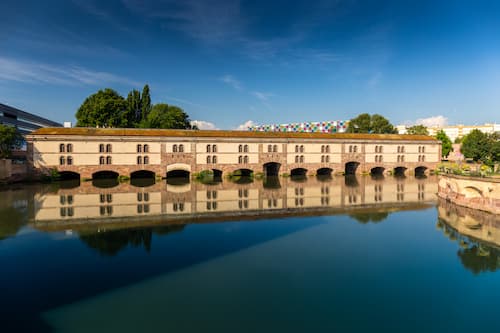
The Vauban dam, Strasbourg's large fortified lock
Passing through Strasbourg, are you planning a visit to the Vauban dam? Did you know that before being a panoramic terrace, this lock-bridge was once a strategic military installation? In the Middle Ages, it was used to defend the southern front of the city, where the Ill river subdivides. Let's discover together the history of the Vauban dam!
The Vauban dam: a witness to the history of Strasbourg
In the 18th century, the city of Strasbourg was protected from attacks by the Covered Bridges with their 4 high medieval guard towers: the Malzenturm, now disappeared, the Heinrichsturm, the Hans von Altheimturm and the Henckerturm. The bridges originally had a tile roof, which disappeared over time.
These towers had a mainly defensive use. However, over the years, modern artillery and technological developments made the defense of the Covered Bridges ineffective. The system being obsolete, it was necessary to find a new way to protect the city. This is when the Vauban dam was built between 1681 and 1688 by the French engineer Tarade based on plans by Vauban, an engineer, military architect, and marshal of France appointed by Louis XIV.
This large fortified lock, spanning the entire width of the Ill, was able to face the new constraints of war. It defended the city in case of a river attack, but also allowed to repel attackers with its flood system.
This building, by obstructing its 13 arches by closing the gates, raised the level of the Ill river. The land being flooded, the city became impenetrable for the enemy. Once the lands were drowned, the troops were bogged down in the marshes and were also hindered by dissuasive harrows. This technique was used in particular during the siege of Strasbourg in 1870.
This is how the Vauban dam was baptized the "Great Lock". It is today classified as a historical monument since May 18, 1971.
The impressive structure of the Vauban dam
The Vauban dam was originally topped with an upper level of half-timbering, surmounted by a gable roof. In 1865, the building underwent a transformation. The structure was raised by a vaulted floor in sandstone and brick, then covered with an earth embankment to resist new modern artillery technologies. Three arches were also raised to respond to the concerns of farmers whose lands were often flooded during the snow melt.
By examining the surroundings of the Vauban dam, you can see two series of embrasures located near the water level. These were to be used to sink enemy boats on the spot.
In addition to its defensive function, the dam made it possible to store flour, in particular on the floor and in the attic of the structure. It was also an essential public passage with its 3 drawbridges to connect the two banks of the Ill. Nowadays, this passage exhibits works, statues of Notre-Dame Cathedral, gargoyles and plaster casts. This place also frequently hosts temporary exhibitions, such as the International Glass Biennial in 2013 and 2015.
Between 2010 and 2012, the city of Strasbourg undertook major restoration, enhancement and safety work, under the direction of the chief architect of historical monuments, Christophe Bottineau:
- creation of a green roof;
- renovation of access to the panoramic terrace;
- restoration of facades and facings.
The panoramic terrace of the Great Lock
Nowadays, the Vauban dam has left its military past behind. The top of the building is now converted into a unique panoramic terrace. It is a privileged place offering the best view of Strasbourg, its Covered Bridges, its picturesque Petite France district and its Notre-Dame Cathedral in the background. You can also observe the winding canals housing the half-timbered houses. At nightfall, this lock-bridge lights up to the delight of visitors!
During your visit to the Alsatian capital, don't miss the opportunity to climb its terrace. It is the starting point for a beautiful walk in the historic center. Two interior staircases are open to the public as well as an elevator for people with reduced mobility.
Practical information to visit the Vauban dam in Strasbourg
To contemplate this sumptuous historical monument, go to the place du quartier blanc, rue Sainte-Marguerite.
By tram, reach the dam thanks to line B or C - Musée d'Art Moderne stop. From the train station, the building is about ten minutes' walk away.
Access to the panoramic terrace varies with the seasons. Do not hesitate to consult the schedules on the website of the Strasbourg tourist office.
The Vauban passage is open all year round from 6 a.m. to 9 p.m.
You can visit the dam alone or accompanied by a guide, and even by segway for an original experience!
On site, do not hesitate to take a look around. You will be near the European Community of Alsace, the Museum of Modern and Contemporary Art of Strasbourg, the Historical Cellar of the Civil Hospices as well as the Saint-Jean Commandery housing the National Institute of Public Service.
After this day of visit, you will need a little rest. We look forward to seeing you in our budget establishment B&B HOTEL Strasbourg Sud Geispolsheim!




















